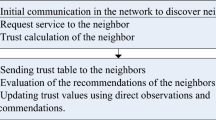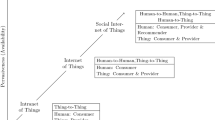Abstract
Today’s electrical and electronic gadgets have become smarter and intelligent. These devices such as sensors, actuators, RFIDs are becoming part of our fabric. Internet of Things (IoT) and Social networking paradigms are not new. The increased pervasiveness has resulted not only in human to thing communication but also thing to thing communication. A new paradigm integrating IoT and Social Networks has emerged in recent years called the Social Internet of Things (SIoT) where objects are not only smarter but also socially conscious. Social Internet of Things is analogous to social network of intelligent objects. Trust is considered as a crucial factor in SIoT for objects to establish reliable autonomous communication. This paper proposes a Trust Management scheme for Social Internet of Things where trust between objects is computed based on Direct Observations, Indirect Recommendations, Centrality, Energy and Service Score of the object. The proposed trust model outperforms the existing trust models leading to a better application performance. The trust model is also tested in the presence of On Off selective forwarding attacks. Experimental results prove that the proposed model is reliable and defendant against On Off selective forwarding attacks.







Similar content being viewed by others
References
Atzori, L., Iera, A., & Morabito, G. (2010). The internet of things: A survey. Computer Networks Elsevier, 54(15), 2787–2805.
Nitti, M., Girau, R., & Atzori, L. (2014). Trustworthiness management in the social internet of things. IEEE Transactions on Knowledge and Data Management, 26(5), 1–11.
Atzori, L., Iera, A., & Morabito, G. (2011). SIoT: Giving a social structure to the internet of things. IEEE Communication Letters, 15(11), 1193–1195.
Kleinberg, J. (2000). The small-world phenomenon: An algorithmic perspective. In Proceedings of the thirty-second annual ACM symposium on theory of computing (pp. 163–170).
Atzori, L., Iera, A., Morabito, G., & Nitti, M. (2012). The social internet of things (SIoT): When social networks meet the internet of things: Concepts architecture and network characterization. Computer Networks, 56(14), 3594–3608.
Adali, S., Escriva, R., Goldberg, M. K., Hayvanovych, M., Magdon Ismail, M., Szymanski, B. K., Wallace, W. A., & Williams, G. T. (2010). Measuring behavioral trust in social networks. In International Conference on Intelligence and Security Informatics (ISI). 150–152).
Saied, Y. B., Olivereau, A., Zeghlache, D., & Laurent, M. (2013). Trust management system design for the internet of things: A context-aware and multi-service approach. Computers and Security, 39, 351–365.
Wang, J. P., Bin, S., Yu, Y., & Niu, X. X. (2013). Distributed trust management mechanism for the internet of things. Applied Mechanics and Materials, 347, 2463–2467.
Bao, F., & Ing-Ray, C. (2012). Dynamic trust management for the internet of things applications. San Jose, CA: International Workshop on Self Aware IoT.
Bao, F., Ing-Ray, C., & Guo, J. (2013). Scalable, adaptive and survivable trust management for community of interest based internet of things systems. Eleventh International Symposium on Autonomous Decentralized Systems (ISADS), 1–7.
Mahalle, P. N., Thakre, P. A., Prasad, N. R., Prasad, R. (2013). A fuzzy approach to trust based access control in internet of things. In 3rd International conference on wireless communications, vehicular technology, information theory and aerospace and electronic systems.
Bachi, G., Coscia, M., Monreale, A., & Giannotti, F. (2012). Classifying trust/distrust relationships in online social networks. privacy, security, risk and trust (PASSAT). In International Conference on Social Computing (SocialCom) (pp. 552–557).
Meena Kowshalya, A., & Valarmathi, M. L. (2015). Improved network navigability and service search in social internet of things (SIoT). International Journal of Research and Scientific Innovation, 2(9), 75–77.
Anna–Kaisa, P., & Christophe D., (2012). CRAWDAD dataset thlab/sigcomm2009 (v.2012–07–15), traceset: mobiclique. doi:10.15783/C70P42.
Chen, D., Chang, G., Sun, D., Li, J., Jia, J., & Wang, X. (2011). TRM-IoT: A trust management model based on fuzzy reputation for internet of things. Computer Science and Information Systems, 8(4), 1207–1228.
Chen, I. R., Guo, J., & Bao, F. (2014). Trust management for SOA-based IoT and its application to service composition. IEEE Transactions on Services Computing, 9(3), 482–495.
Saied, Y. B., Olivereau, A., Zeghlache, D., et al. (2013). Trust management system design for the internet of things: A context-aware and multi-service approach. Computers & Security, 39, 351–365.
Author information
Authors and Affiliations
Corresponding author
Rights and permissions
About this article
Cite this article
Kowshalya, A.M., Valarmathi, M.L. Trust Management in the Social Internet of Things. Wireless Pers Commun 96, 2681–2691 (2017). https://doi.org/10.1007/s11277-017-4319-8
Published:
Issue Date:
DOI: https://doi.org/10.1007/s11277-017-4319-8




